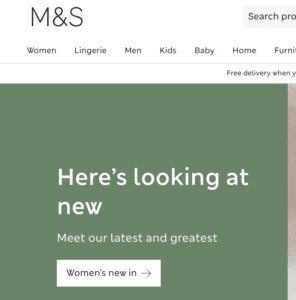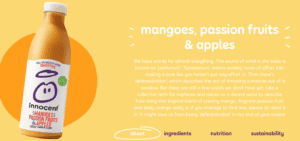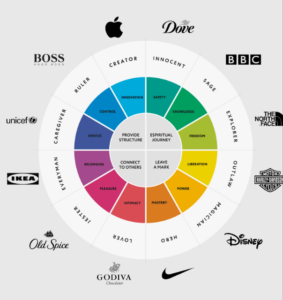
Set The Tone For 2024: Why TOV Matters In Content

How does your business sound? Is it young and agile? Or assured and grounding? Or maybe it’s a little over the place. Wherever it is at the moment, you should be asking yourself, “what is tone of voice” – and how do you use it for the best results?
So with that in mind, this blog will look at how to create a positive tone of voice (TOV) that speaks to your audience, and sets the stage for your business wherever you are.
By pulling together industry insights and insider knowledge from our very own content marketing team, this is your go-to guide for all things ‘brand-speak’.
Let’s get started.
What is a tone of voice?
“Essentially, a tone of voice is what sets you apart from your competitors,” says Cara Dudgeon, Content Writer at Embryo.
“For example, you can instantly recognise Marks and Spencer’s TOV because of its distinctiveness – even if you’re listening to an advertisement or reading a label. It is how your brand sounds, and it’s an easy way for your target market to know who you are without even seeing the logo.”
In marketing, a tone of voice encapsulates your brand’s complete personality. It forms the building blocks of ‘how’ a business speaks to its customers, spanning the following:
- Word choice
- Emotional tone
- Communication style
Much like our spoken language, your tone of voice can change depending on the situation. But in marketing, that usually means it adapts, rather than completely shifts, across different channels, purposes and more.
Why Tone Of Voice (TOV) Matters In Content
When it comes to writing content, your TOV matters for various reasons, whether that’s for trust, giving off emotional signals or simply providing a stronger focus.
According to Customer Thermometer, 65% of customers say that they are emotionally connected to a brand in a way that makes them feel as if the company cares about them.
A caring or friendly attitude towards your audience can prompt them to interact with you more, giving you a chance to offer them a solution to their needs.
A strong TOV builds trust with your audience.
In one study by Harvard Business Review, 64% of customers cited that shared values are the primary reason to trust a company, among those who said they have a brand relationship.
To work towards this goal, you can highlight your charitable work, donations, and important events happening in the company – especially those your audience can participate in.
Stand out from the crowd.
A good TOV is what makes you different.
Communicating passionately, quietly or angrily can completely impact how people interpret you. If voice and tone were not considered, everybody’s business would seem like it was run by the same people, with little to differentiate. Your fantastic, value-adding and unique business wouldn’t be distinguishable from any other.
An expert touch.
Tone of voice can demonstrate your warmth, expertise, sense of humour, or any other attribute that you want to display to consumers, and sets you apart from your competition. This is especially handy when your communication isn’t happening face-to-face. It replaces face-to-face communication.
According to Forrester Research, business buyers don’t contact suppliers directly until they are up to 90% of the way through the purchase process. With fewer opportunities to talk face-to-face, your written words have to work harder than ever. Potential clients and customers may know you from your website and marketing material before they ever pick up the phone.
Your tone helps to build trust with them from the start, laying the foundation for a strong working relationship. We’ve evolved to be highly attuned to subtle signals such as emotion, body language, gesture, voice, and so on. In writing, all those signals are carried by tone of voice, so that’s the only way to show your identity, your personality, and your intention.
A little more focus.
Working on a tone of voice can be an excellent discipline for thinking about your company’s identity. You have to boil everything down to something clear and simple that anyone can understand. That helps to cut through clutter and confusion of other brands. Your tone can even help you set strategic direction.
Markets are getting more crowded and competitive, so companies have to decide on their brand personality. Instead of being all things to all people, embracing a niche appeal so you can hone in on the most relevant audience – which we’ll look at in the next section.
Tone of voice examples

Here’s a snippet from the iconic Marks and Spencers. Although a more upmarket offering than its competitors, such as ALDI or LIDL, it still exudes a warmth that more premium supermarkets like Waitrose don’t have – attracting a new generation of shoppers to M&S!

Another unmistakable TOV is Innocent Smoothies. Often imitated, their tongue-in-cheek voice is surprisingly adaptable across a range of applications, from their website to their labels to even the bottom of their bottles.

Then, on the other hand, is Apple. They are pioneers and innovators but as a tech company, have little time for whimsy. Their TOV is direct and powerful, as slick as the products they sell – making them appear cool, calm and collected. Even if the technology is complicated, they know their audience are looking for the bare-bones information, making this tone of voice a great example of ‘less being more.’
How does Embryo create a TOV?
When we onboard a new client for a content marketing project, tone of voice is usually the first place our writers start.
“We ask questions on customer profiles,” says Cara. “We want to get to the bottom of how you want to sound, what your audience might be used to hearing, but most importantly, we need to know how you don’t want to sound.
“Having clear no-no’s allows you to set parameters and boundaries, so you know how to play with language without going too far.”
From these conversations, we create a complete tone profile, including building blocks like core values, USPs and the most common phrases used by your business and industry.
This gives our writers a go-to dictionary that looks, sounds and feels expert – no matter what they’re writing.
How To Create Your Brand’s Tone of Voice
So, when it comes to creating your tone of voice, it all starts with understanding who your audience is, and choosing the right language to appeal to them. Then you need to determine the brand’s values that you should keep in mind when creating future content.
With these elements defined, you can establish clear tone of voice guidelines to ensure that the tone comes through in every communication your brand sends out – whether that’s social media posts, blogs, articles or email newsletters, for example.
As team members become more familiar with the guidelines and how to use the brand’s preferred tone, it becomes easier to create new content that falls in line with this, for consistent and effective communication.
Getting To Know Your Audience
A report by Econsultancy and IBM suggested that 56% of consumers felt most brands’ communication was irrelevant. To understand how to approach them and deliver relevant messages, you have to research your audience and adapt your content to meet their needs.
If you’re into buyer personas, you could use Google Analytics and social networks analytics data – such as age, interests, education, job title – to help identify the tone of voice you could be using.
For example, if you’re looking to target business professionals in the law industry, researching their interests could help to identify topics for blogs, articles and whitepapers, and competitor research could help identify a TOV that you can emulate. If you’re looking to target a young audience for example, you may opt for an informal, fun and friendly tone.
You can also look at:
- GOALS
- CHALLENGES
- HOW WE SOLVE THEIR PAIN POINTS
- PREFERRED CHANNELS
- COMMUNICATION STYLE
Using audience insights
Another great way to determine your TOV – is to discover how your audience talks and interacts with each other. Watch how your audience communicates with each other, what they like and dislike in discussion threads, what the overall tone of discussions is, and what language people use, to help you create the most popular content.
Studies suggest that emulating or mirroring the vocabulary of a particular group allows people to feel a sense of belonging. Mirroring your audience’s language will make your content pieces more relatable and bring your brand closer to them.
Communicating Brand Values
To define your core values, try answering these questions:
- Why was the company set up?
- What makes your brand unique?
- What do you stand for as a brand?
- What values do you want to share with your audience?
Then, you should answer the following questions:
- Who are we as a company?
- Who would we like to be?
- Who do we not want to be?
Consider language and tones that align with the second question, and how you can portray this within your content.
It may be worth going through evergreen blogs, articles and website content to check that all content aligns with ‘who you would like to be’. A refresh, update or rewrite may be required.
Conveying semantics
“The tone doesn’t change, but the voice in your head does” – May Habib
Rather than thinking of ‘tone’ as a concrete thing, think more along the lines of how your reader will engage with your copy. The next section focuses on how this client’s words are ‘heard’, even if it’s all on a webpage.
What should the reader experience and feel on this particular website? What are the experiential factors that play into it? For example, is it elevated? Warm? Assured?
All these things can impact your tone of voice.
Using archetypes in tone of voice
In the 1940s, Swiss psychologist Carl Jung developed a set of common personality archetypes.
As individuals, we can all inherently recognise and relate to the archetypes. They play a role in influencing our behaviour on a subconscious level, leading to typical behavioural patterns, desires, values and motivations.
Some provide structure, help with their knowledge journey or leave a lasting impression.
One, or more, will resonate with your readers – and can be crafted with tone, pacing, word choice and strapline.
Note: These are different from customer personas, which are ‘controlled’ projections.
In contrast, think of archetypes as the ‘knee-jerk’ voices that our readers will recognise – making them useful starting blocks for tone of voice ideation.

Defining Your Brand’s TOV
Now comes the fun part. With all of this prior information to hand, you get to choose the actual tone of your content. Do you want it to be funny, lighthearted, and friendly? Perhaps professional, serious and formal is more your thing? Whatever you decide, it’s important that it aligns with your brand, your values and how you want to be perceived by your audience.
One of my favourite strategy documents that we do here at Embryo is the TOV document. By researching competitors and condensing this down into adjectives that describe their TOV, we can build upon this for our clients’ success.
Your brand’s TOV sets the stage for your company’s communication, expressing your brand’s personality and set of values. It’s the foundation of your marketing strategy, and should be adhered to at all times.
If you’d like to learn more about creating your own TOV, get in touch with Embryo today.
FAQS
What is tone of voice in branding
Tone of voice in branding refers to the unique way a business communicates with its target audience. This can be through written or spoken content – spanning homepages, product listings and resources – that not only conveys useful information, but translates your brand’s personality into recognisable touchpoints.
Does my tone of voice change across channels?
A tone of voice should stay consistent across your marketing channels, but you might need to tweak it to suit a new platform. As long as you remain consistent at your core, your TOV will still be recognisable and trusted.
However, things like platform norms, audience expectations and even content format can influence your tone, so pay attention to factors like word count and overall demographic.



